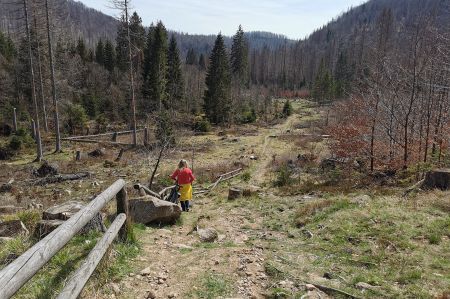With the e-bike along the Rehberger Grabenweg
- Written by Portal Editor
Once again, we wanted to explore a target path with the e-bike from the Prahljust campsite near Clausthal-Zellerfeld, this time it should go along the Rehberger Graben, which we wanted to ride coming from the Oderteich.
Since we have already repeatedly pointed out the beautiful cycle routes along the ditch system in the Harz water shelf, we will now save ourselves the description of the route to the Oderteich. By the way: It is better to hike around the Oderteich only on foot, not by bike, as large parts lead over wooden footbridges and are heavily used by hikers.
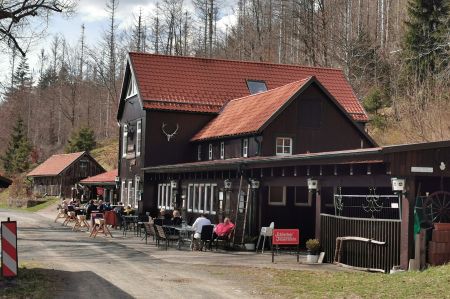 The Rehberger Graben was created by Sankt Andreasberg miners at the end of the 17th century to divert water from the Oder to Sankt Andreasberg. The Rehberger Graben is about 7.25 km long and is therefore also an important part of the Upper Harz water regime. Like the other ponds and ditches, the Rehberger ditch was created to supply energy by means of water wheels in the local mines. Since we have already reported on the Oderteich itself and hiked around it, we begin our tour at the outlet of the Oderteich into the ditch system.
The Rehberger Graben was created by Sankt Andreasberg miners at the end of the 17th century to divert water from the Oder to Sankt Andreasberg. The Rehberger Graben is about 7.25 km long and is therefore also an important part of the Upper Harz water regime. Like the other ponds and ditches, the Rehberger ditch was created to supply energy by means of water wheels in the local mines. Since we have already reported on the Oderteich itself and hiked around it, we begin our tour at the outlet of the Oderteich into the ditch system.
The Rehberger Graben - a cycle path without major inclines
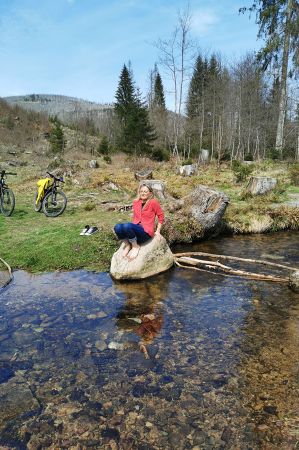 The Rehberger Graben runs from the Oderteich along the east side of the 893 m above sea level. NN high Rehbergs to Jordan height just before Sankt Andreasberg. From there it runs underground through the 760 m long Tiefen Gesehr watercourse (completed as early as 1699 with a gradient of approx. 8 m) to Sankt Andreasberg. Immediately next to the ditch, a roadway-wide inspection and maintenance path was created, which is widely known as a popular cycling and hiking path under the name Rehberger Grabenweg. In the course of the Rehberger Grabenweg there are numerous information boards that provide information about the Graben itself and the surrounding nature, especially about the so-called water hiking trails. Like the Rehberger Graben itself, it leads from the Oderteichdamm to the Jordanshöhe, then another 1.5 kilometres to the centre of Sankt Andreasberg. The path is particularly suitable for leisure cyclists because, similar to a railway cycle path, it has hardly any inclines. The Rehberger Grabenweg is also part of the southern Brocken bypass of the Harzer Hexenstieg.
The Rehberger Graben runs from the Oderteich along the east side of the 893 m above sea level. NN high Rehbergs to Jordan height just before Sankt Andreasberg. From there it runs underground through the 760 m long Tiefen Gesehr watercourse (completed as early as 1699 with a gradient of approx. 8 m) to Sankt Andreasberg. Immediately next to the ditch, a roadway-wide inspection and maintenance path was created, which is widely known as a popular cycling and hiking path under the name Rehberger Grabenweg. In the course of the Rehberger Grabenweg there are numerous information boards that provide information about the Graben itself and the surrounding nature, especially about the so-called water hiking trails. Like the Rehberger Graben itself, it leads from the Oderteichdamm to the Jordanshöhe, then another 1.5 kilometres to the centre of Sankt Andreasberg. The path is particularly suitable for leisure cyclists because, similar to a railway cycle path, it has hardly any inclines. The Rehberger Grabenweg is also part of the southern Brocken bypass of the Harzer Hexenstieg.
Small stopover at the Rehberger Grabenhaus
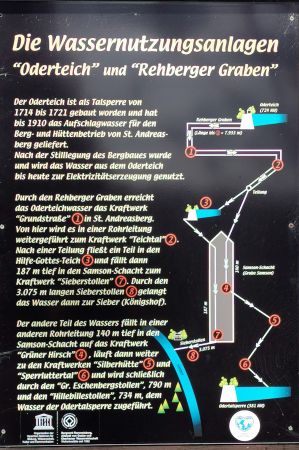 As already reported, we will now save ourselves the description of the route to the Oderteich, but once again it was a pleasure to cycle the approximately 20 kilometres through the landscape far away from the busy country road, whereby there was a section with a downhill run that was quite a challenge had. First of all quite steep, then boulders along the way and gnarled tree roots. Only later did we realize that it would have been possible to drive around. After a further 5.8 kilometres from the Oderteich we reach the Rehberger Grabenhaus, a typical mountain inn or hut run by young people. Very friendly and came up with some special dishes. So, it's no wonder that today it's a popular destination for backpackers and cyclists. We also hear about the winter evenings by the fire on site, from where you can watch the wild animals being fed at close range.
As already reported, we will now save ourselves the description of the route to the Oderteich, but once again it was a pleasure to cycle the approximately 20 kilometres through the landscape far away from the busy country road, whereby there was a section with a downhill run that was quite a challenge had. First of all quite steep, then boulders along the way and gnarled tree roots. Only later did we realize that it would have been possible to drive around. After a further 5.8 kilometres from the Oderteich we reach the Rehberger Grabenhaus, a typical mountain inn or hut run by young people. Very friendly and came up with some special dishes. So, it's no wonder that today it's a popular destination for backpackers and cyclists. We also hear about the winter evenings by the fire on site, from where you can watch the wild animals being fed at close range.
We continue to Goetheplatz - a little history along the way
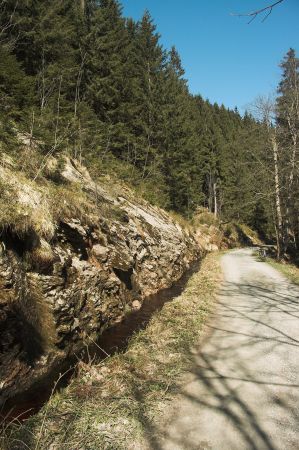 Goethe also hiked this Rehberger Grabenweg in 1783 and 1784 during his 2nd and 3rd Harz journey. At the time, he had Friedrich Wilhelm Heinrich von Trebra, Vice Mining Captain at the time, show him the contact he had discovered between granite and a metamorphic greywacke, the Hornfels, at today's Goetheplatz (a former quarry used to extract the cover slabs for the Rehberger Graben) (see the inscription on the sign at Goetheplatz).
Goethe also hiked this Rehberger Grabenweg in 1783 and 1784 during his 2nd and 3rd Harz journey. At the time, he had Friedrich Wilhelm Heinrich von Trebra, Vice Mining Captain at the time, show him the contact he had discovered between granite and a metamorphic greywacke, the Hornfels, at today's Goetheplatz (a former quarry used to extract the cover slabs for the Rehberger Graben) (see the inscription on the sign at Goetheplatz).
Trebra had two large pieces prepared from the contact at the Rehberger Graben and gave them to Goethe 30 years later, who had them incorporated into two coffee tables. One of them is shown on the sign at Goetheplatz and is now in the mineralogical collection of the Friedrich Schiller University in Jena. The second table is now on the 1st floor of Goethe's garden house in Weimar.
 At the time, Goethe was a supporter of Neptunism, the theory that claims that all rocks come from the oceans. He observed on the exposed rock how the very hard and tough hornfels had formed through the penetration of molten granite into the older slate and greywacke rock.
At the time, Goethe was a supporter of Neptunism, the theory that claims that all rocks come from the oceans. He observed on the exposed rock how the very hard and tough hornfels had formed through the penetration of molten granite into the older slate and greywacke rock.
Goethe said that this passage proves Neptunism, since the granite as a primary rock from the sea (probably because of the granular structure from the components quartz, feldspar and mica) is overlaid by a granular rock also from the sea, the greywacke.
Here dear Mr. Goethe was wrong, because the granite rose as magmatic rock to greywacke 295 million years ago and then metamorphosed this greywacke into horn rock. Only shortly before his death did Goethe correct his view, which was no longer tenable due to the mineralogical knowledge gained in research.
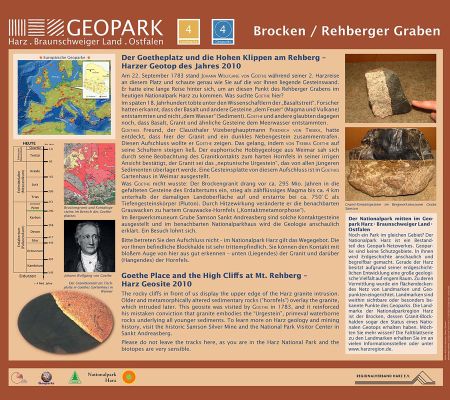 Until 2014, the Wilhelm-Block-Hütte was located directly above the Goetheplatz, the oldest hut of the Harz Club branch association Sankt Andreasberg. This hut was dismantled by the Harz National Park. A path that is difficult to walk, especially in winter, runs directly past this former hut from Goetheplatz up to the Rehberger Planweg.
Until 2014, the Wilhelm-Block-Hütte was located directly above the Goetheplatz, the oldest hut of the Harz Club branch association Sankt Andreasberg. This hut was dismantled by the Harz National Park. A path that is difficult to walk, especially in winter, runs directly past this former hut from Goetheplatz up to the Rehberger Planweg.
We decide to do a final, short round trip through St. Andreasberg and then drive back to the campsite in Clausthal-Zellerfeld.
Please read as well:
Paddling on the Unstrut - from Roßleben to Kirchscheiden
Münch - motorcycle brand with a large fan community
-
 Biking along Rehberger Grabenweg / Harz
Biking along Rehberger Grabenweg / Harz
Biking along Rehberger Grabenweg / Harz
Biking along Rehberger Grabenweg / Harz
-
 Biking along Rehberger Grabenweg / Harz
Biking along Rehberger Grabenweg / Harz
Biking along Rehberger Grabenweg / Harz
Biking along Rehberger Grabenweg / Harz
-
 Biking along Rehberger Grabenweg / Harz
Biking along Rehberger Grabenweg / Harz
Biking along Rehberger Grabenweg / Harz
Biking along Rehberger Grabenweg / Harz
-
 Biking along Rehberger Grabenweg / Harz
Biking along Rehberger Grabenweg / Harz
Biking along Rehberger Grabenweg / Harz
Biking along Rehberger Grabenweg / Harz
-
 Biking along Rehberger Grabenweg / Harz
Biking along Rehberger Grabenweg / Harz
Biking along Rehberger Grabenweg / Harz
Biking along Rehberger Grabenweg / Harz
-
 Biking along Rehberger Grabenweg / Harz
Biking along Rehberger Grabenweg / Harz
Biking along Rehberger Grabenweg / Harz
Biking along Rehberger Grabenweg / Harz
-
 Biking along Rehberger Grabenweg / Harz
Biking along Rehberger Grabenweg / Harz
Biking along Rehberger Grabenweg / Harz
Biking along Rehberger Grabenweg / Harz
-
 Biking along Rehberger Grabenweg / Harz
Biking along Rehberger Grabenweg / Harz
Biking along Rehberger Grabenweg / Harz
Biking along Rehberger Grabenweg / Harz
-
 Biking along Rehberger Grabenweg / Harz
Biking along Rehberger Grabenweg / Harz
Biking along Rehberger Grabenweg / Harz
Biking along Rehberger Grabenweg / Harz
https://www.alaturka.info/en/bicycle-travelling-e-bike-camping/6185-with-the-e-bike-along-the-rehberger-grabenweg#sigProId4bf7a9cc6e
